Yep, you read that right, some dogs have webbed feet — they’re not just for ducks!
In fact, there are a number of dog breeds that have webbed feet.
In most cases, webbed paws help dogs to swim more efficiently, but there are a few more benefits to having webbed paws, which we’ll go through in more detail below.
Read on to learn about 13 dog breeds with webbed feet — you may be surprised by some of the breeds listed below!
Dogs with Webbed Feet: Key Takeaways
- All dogs start life with webbed feet, but most lose the majority of their webbing early in life.
- Webbed paws help dogs swim more efficiently, but they’re also useful for digging and walking on soft or muddy surfaces.
- There are a number of breeds that have webbed paws, including Labs, poodles, dachshunds, and more.
Webbed Dog Paws 101: Why Do Some Dogs Have Webbed Feet?
The “webbing” of a dog’s paws is a membrane of connective tissue and skin between the dog’s toes.
You may already be aware of a number of animals that have webbed feet, but did you know that most land mammals begin life with them?
While most species tend to lose the majority of the webbing before birth, every dog breed will retain some of it (although you won’t really notice it in most breeds).
On rare occasions, dogs and other animals can be born with all of the webbing intact. Dog breeders have used this “birth defect” to their advantage and bred dogs to produce puppies with webbed paws.
The Benefits of Webbed Feet in Dogs
There are several different benefits webbed feet provide dogs.
As mentioned earlier, webbed feet can help dogs swim more efficiently — the webbing allows them to paddle quicker and be more controlled in their movements in the water.
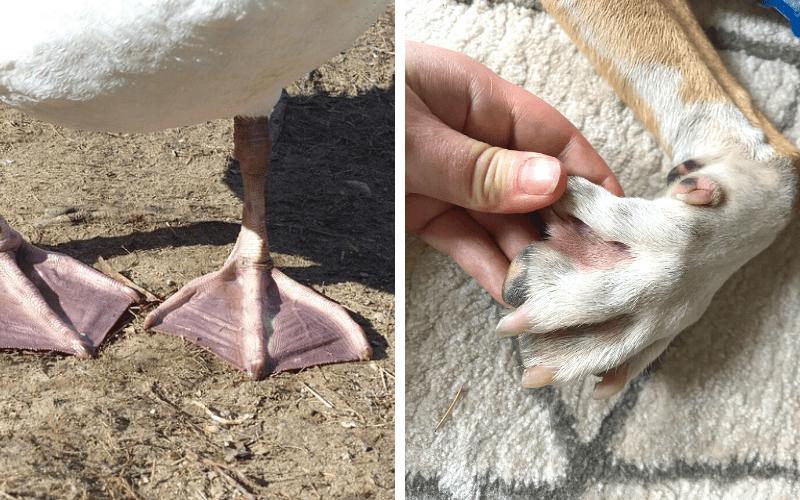
You can understand now that, if a breeder was looking to create dogs who could work in and around water (such as search and rescue dogs), webbed feet could be incredibly beneficial.
Webbed feet can also make it easier for dogs to dig. The webbing essentially functions like a shovel blade, allowing them to move dirt around more easily.
For dogs whose work involves digging up varmints, this is ideal.
Webbed feet also proved helpful for those dogs working in swampy areas or on soft ground — you’re not going to see these type of dogs slipping and sliding around in the mud!
13 Dogs with Webbed Feet
Now that you understand some of the benefits webbed feet provide, we can dive into a few of the most notable dog breeds with webbed feet!
1. Labrador Retrievers
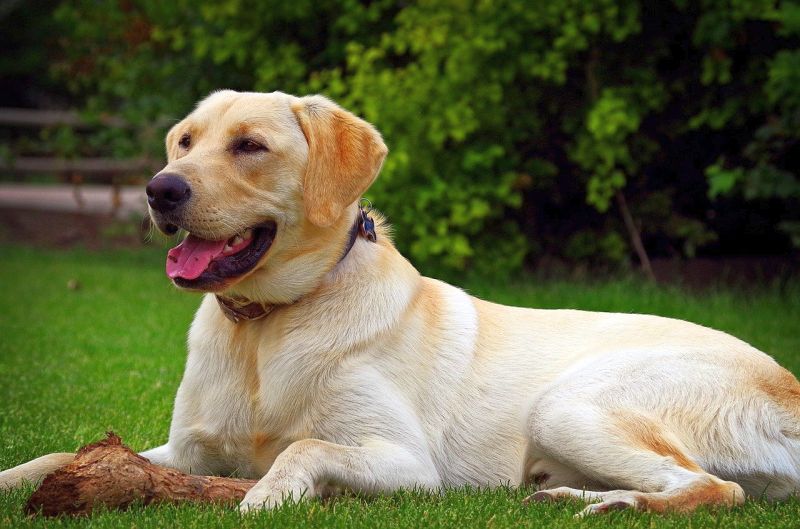
Chances are, you already know of, love, or own a Labrador retriever. The most popular of all breeds, they are wonderful family pets due to their friendly, affectionate nature.
Many Labradors and Lab mixes make for fantastic service or police dogs due to being so intelligent and sociable. Their grooming regime is fairly low maintenance too.
They’re famously food-orientated so are very easy to train, but you’ll find that they’ll need a lot of exercise to balance their love of food and high-energy temperament.
Like many dogs, insufficient exercise and stimulation can lead to a Labrador retriever becoming hyperactive and destructive.
Taking them on a walk to a safe body of water is an excellent form of exercise for a Labrador retriever — it combines their two favorite things, swimming and retrieving!
Not unlike their fellow mammal the otter, Labradors have a double layered, water repellent coat, a strong, rudder-like tail to steer them through the water, and large webbed paws. This winning combination makes them wonderful, confident swimmers!
2. Newfoundlands
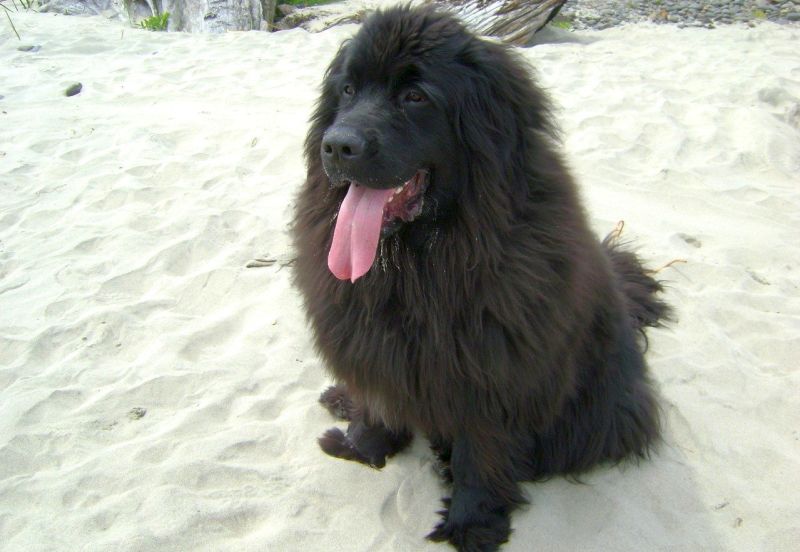
With even thicker fur than Labradors, Newfoundlands have waterproof coats and webbed paws allow them to stay in the water for long periods of time.
This originally made them fantastic partners for fishermen in Canada. Their strong, sturdy frames and impressive physical stamina meant that they could pull nets and fetch fish for their fishermen owners.
In more modern times, you’ll often find a Newfoundland working in search and rescue, or simply being a brilliant family member. They are dogs that love the outdoors and will make an ideal companion for long hikes and lake trips.
Although their giant size and strength may be intimidating for some, it’s important to know that Newfoundlands are very sweet and gentle, especially with children.
If you’re considering adding a Newfie or a Newfie mix to your family, it’s not a bad idea to get the children involved with the grooming — it’ll need to be done at least once a week, and can be a great bonding activity!
3. Poodles
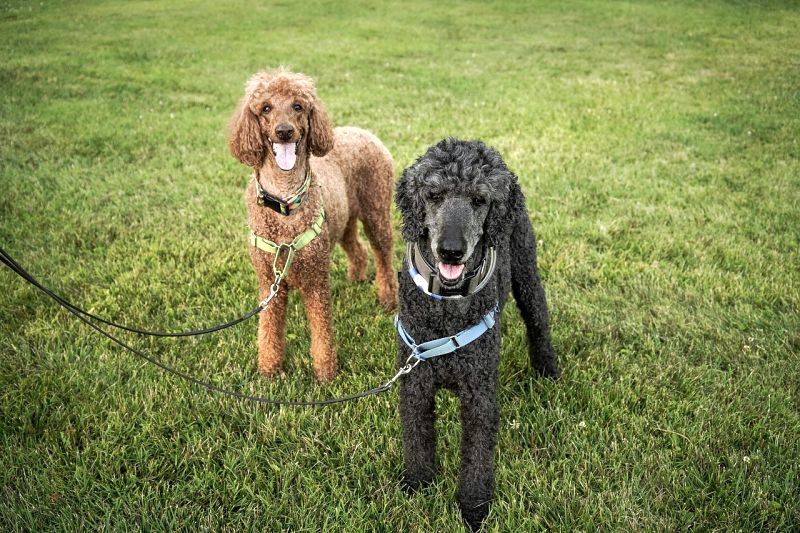
Clever, curly, and cute, poodles are a breed often associated with stylish city folk — but they are surprisingly comfortable enjoying the great outdoors too!
Unlike other dogs with webbed feet that tend to have oilier fur, the poodle has a very soft, low allergen coat.
It’s important to note that a poodle’s coat needs daily grooming to prevent the fur from getting matted. But the upside? Poodles are a breed that barely shed!
Poodles are one the most intelligent breeds around, so they’re the ideal dog to get involved in agility or obedience training.
They love to swim, so it’s important to regularly incorporate swimming into your dog’s exercise routine. Poodles have a lot of energy that needs expending!
Poodle’s are excellent retrievers and were originally bred to retrieve waterfowl — their webbed paws allowing them to be quick and precise while working in the water.
Note that poodles come in several sizes, meaning that you should be able to find one that’s a perfect match for your family!
4. Portuguese Water Dog
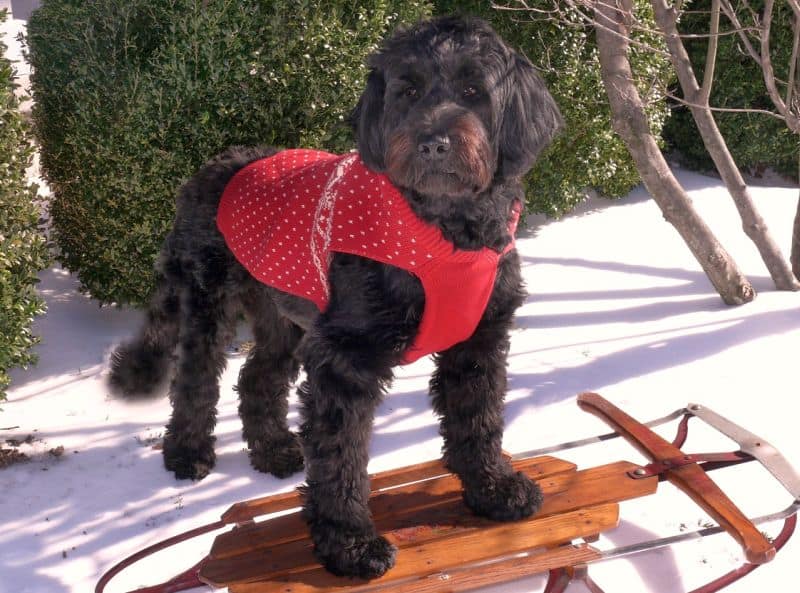
While the Newfoundlands’ incredible strength meant that their line of work revolved around heavy duty lifting, the Portuguese water dog however, was used for herding due to his much smaller frame.
These dogs could herd schools of fish into the nets, saving fishermen a lot of time and energy. As you can imagine, the Portuguese water dog likes a lot of exercise!
While their fishing days may be over, Portuguese water dogs make great companion dogs, who’ve retained a lot of the working dog traits: They’re eager to please their humans, loyal, energetic, and enthusiastic. Oh, and they’re very good at swimming! Good thing they have those webbed feet, right?
Like poodles, Portuguese water dogs have “hypoallergenic” coats that don’t shed very much, making them a perfect dog breed for those who suffer from allergies!
5. American Water Spaniel
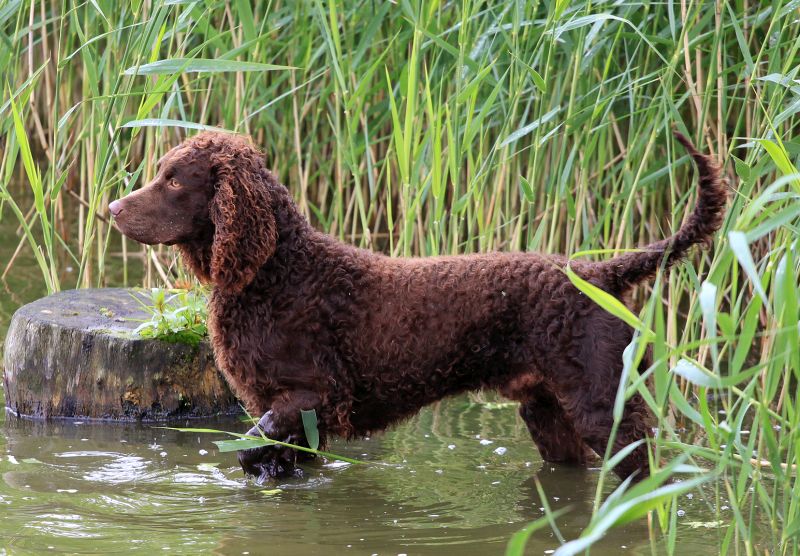
There’s a clue that these pups are dogs that have webbed feet right in their name!
American water spaniels are totally at ease in water. They’ve got an oily outer coat to repel water and thickly padded, webbed feet. They also have nimble frames, which allow them to get in and out of the water without issue.
American water spaniels were bred to work, and if not working, they will require a lot of mental and physical stimulation in the form of swimming, training, playing and vigorous walking or running. Without that, they can become very vocal and barky, as well as destructive.
This breed is especially owner-orientated so while they are quick to learn and train, you may find your American water spaniel disinterested in house guests or neighbours.
6. German Wire-Haired Pointer
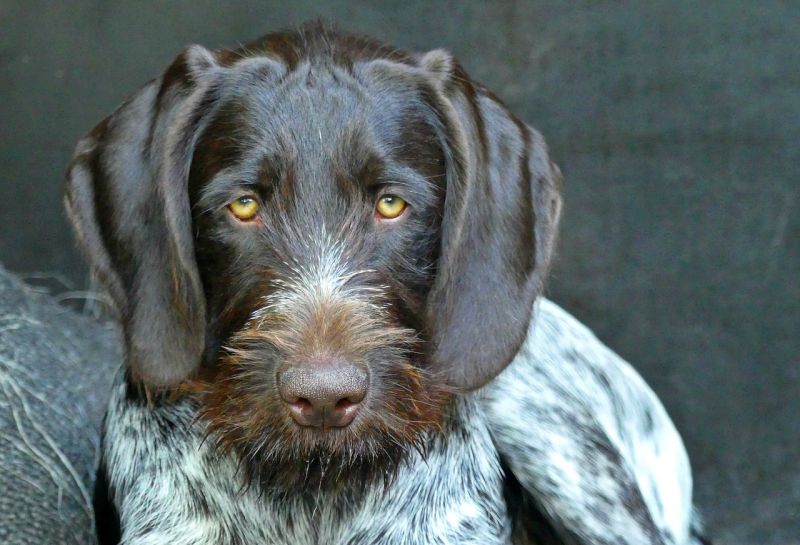
Selective breeding gave the German wire-haired pointer a nifty weatherproof coat (it insulates them in the winter and cools them in the summer), an excellent sense of smell and — you guessed it — webbed feet.
You’ll recognize these lovely dogs from their characteristic beards (just check out the handsome fella pictured above) and dabbled fur coats. Their coats are actually quite easy to care for and require little to no maintenance.
Known as a gun dog breed, the German wire-haired pointer is high energy, responsive and smart.
It’s worth getting your German wire-haired pointer involved in an activity such as canicross, rally, agility, tracking, or hunting in order to provide them with adequate exercise for both brain and body! It’s also a great hobby for humans too.
7. German Short-Haired Pointer
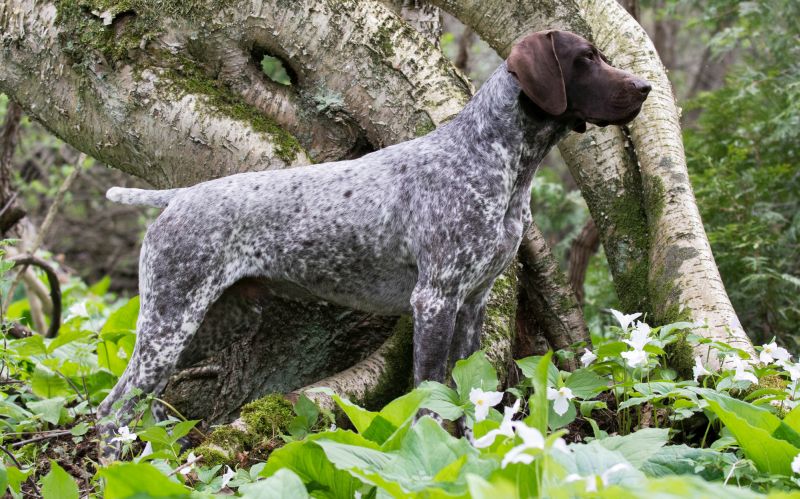
Like their wire-haired counterparts, these dogs are streamlined and powerful hunters. Their paws are distinctly small in size and ‘scoop-like’, allowing them to paddle through the water with ease.
German short-haired pointers are pretty affectionate doggos, who bond quickly with their families. However, given their high energy levels, they’ll be happiest with active humans, who like to go on long walks and frequent adventures with the pooch.
German short-haired pointers are all-around hunting dogs, who were bred to perform a variety of different gun dog roles. And while they are comfortable working upland habitats, forests, and fields, their webbed feet allow them to paddle like pros.
8. Dachshund
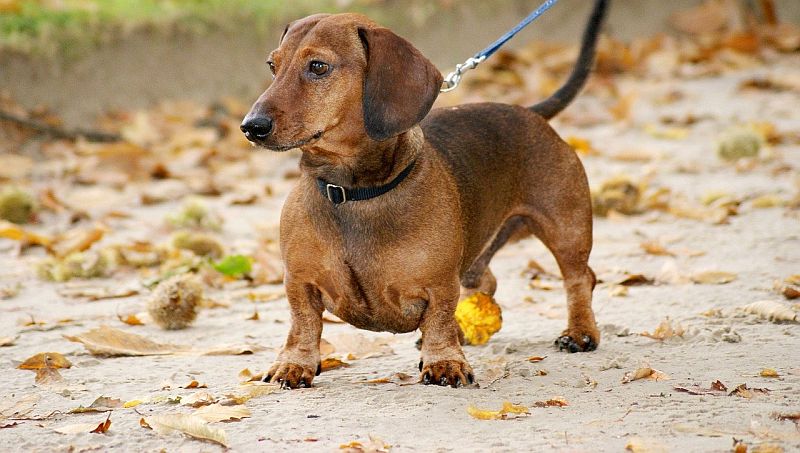
The sweet little sausage dogs we’ve all grown to know and love were originally bred for hunting!
Their famously long, slender bodies enable them to get into tight spaces to find mammals such as badgers and rats.
This is the first dog we’ve featured on our list that has webbed feet, not for the purpose of swimming, but to make their paws into strong, shovel-like tools for digging!
While the dachshund is not averse to swimming, they are not likely to want to do anything long distance. It is important however, to make sure a dachshund gets good exercise to maintain the muscles supporting their long, delicate spines.
Dachshunds come in several types, with variations based on size and coat (the smooth-coated are definitely the easiest to groom).
It’s also vital to watch your dachshund’s body weight — they don’t need any further pressure on their bones!
Dachshunds are wonderfully affectionate and respond well to praise, but can be stubborn to train. As mentioned, they were bred to stay focused on their hunting mission — so in your home, it might be difficult to get their full attention!
Just note that dachshunds are sensitive souls and will not respond well to punishment-based training. Stick to force-free, positive reinforcement training for these guys!
9. Weimaraner
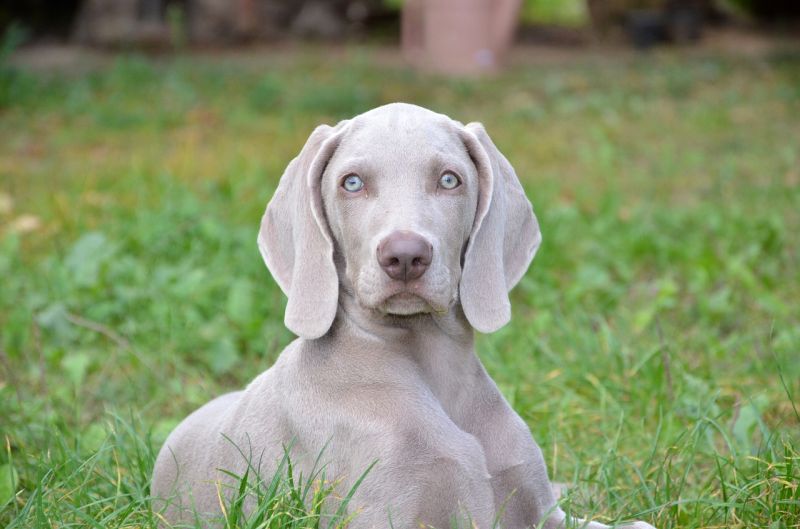
Have you ever met a Weimaraner and noticed how poised and elegant they are while sitting?
They may have inherited that from their canine ancestor; Weimaraners were used as hunting dogs by royalty in the 18th century. They’re intelligent, loving pets and are a great addition to a family.
Don’t worry, their regal roots haven’t made them high-maintenance hounds! Weimaraners and Weimaraner mixes are usually fun-loving goofballs when hanging out with their people.
Their sleek glossy coats are easy to groom, you’ll just need to pay attention to nail trimming (like all breeds) and keeping their long ears clean. The structure and shape of Weimaraner’s ears means that airflow is restricted which can result in a higher risk of infection.
If you’re looking for a motivated running partner, a Weimaraner is the pet for you. Their long limbs need to be stretched out by regular running opportunities! Their large, arched toes and webbed feet can get them through any terrain with speed.
10. Otterhound
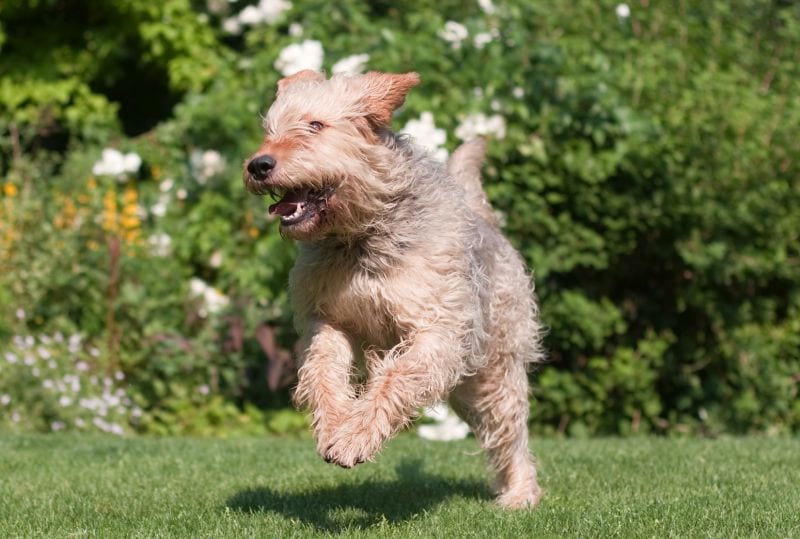
A lesser known breed, the otterhound originated in the UK.
Boisterous and bouncy, these hunting dogs are top-notch swimmers thanks to their broad shoulders, rough coats, large webbed feet, and muscular build.
Their incredibly strong sense of smell could be put to good use with some fun enrichment games at home!
Despite their working background, otterhounds are warm and friendly to children and other dogs alike.
Well worth considering if you are looking for a unique addition to the family, the otterhound only needs brushing once or twice a week, and they thrive on praise and treats. This makes them wonderful at learning new tricks and basic obedience.
A number of otterhound owners have noted the need for a high, secure fence in the backyard, as their tall, agile frames mean they can jump quite high.
These guys aren’t ‘self-starters’ so to speak and would rather lounge on the sofa than exercise in the garden — they’ll need some encouragement and lots of walks with good sniffing spots!
11. Chesapeake Bay Retriever
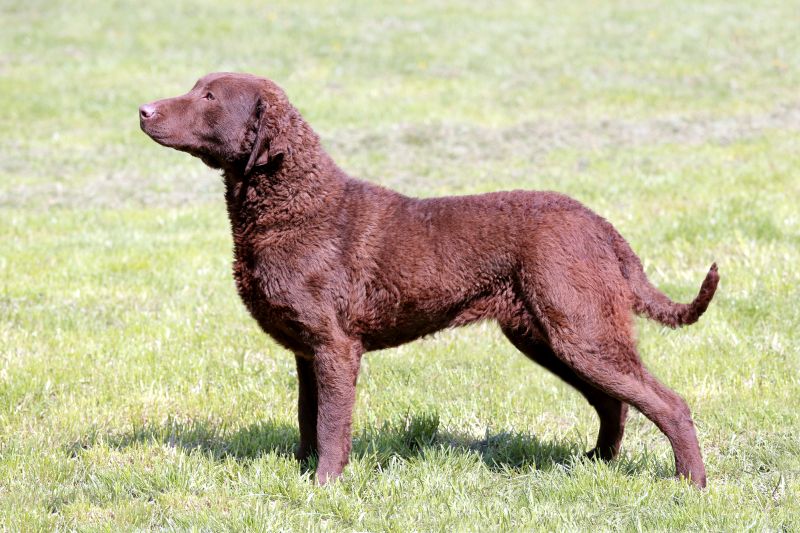
A fiercely loyal breed, the Chesapeake Bay retriever is a brilliant companion.
‘Chessies’ thrive in work, but will otherwise need an active human to go on plenty of outdoor adventures with! Aesthetically they are not dissimilar to Labrador retrievers, with the exception of their wavy coat.
Long used for hunting ducks in the icy cold waters of Chesapeake Bay, this breed of dog put their webbed feet, rounded supportive toes, and strong muscular frame to good use when swimming. Although their fur is short, it is well insulating and thick.
The Chesapeake Bay retriever has a pretty interesting origin story.
Some historical sources have revealed that in 1807, two puppies named ‘Sailor’ and ‘Canton’ were bought from a ship in Maryland for their “great reputation as water dogs” and “duties connected with duck hunting,” with coarse fur of a “dingy red color” and light colored eyes.
While no official breeding records are present, it is believed these dogs were then bred with local bay area dogs to eventually create the Chesapeake Bay retriever, officially recognized as such by the American Kennel Club in 1918.
12. Nova Scotia Duck Tolling Retriever
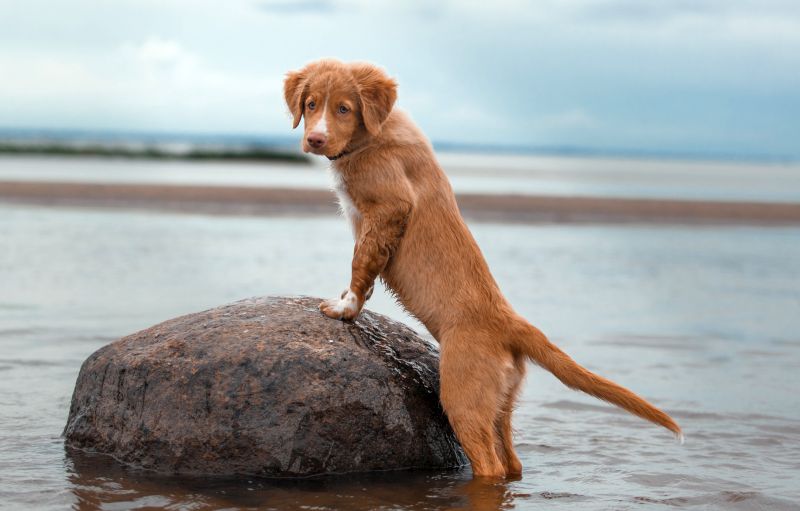
For those that didn’t know, the word “tolling” describes their ability to entice prey into a shooting range or trap.
The Nova Scotia duck tolling retrievers were bred to hunt in water, and are easily recognizable by their strikingly copper red, thick coat of fur.
More webbing in their paws than most webbed-feet breeds means that they are the quickest most agile swimmers that we’ve mentioned in this article.
Nova Scotia duck tolling retrievers require very little grooming. A weekly brushing while paying careful attention to the backs of the ears (where the fur is finer and easily knotted) will suffice. You may need to trim excess fur between the pads of their feet in order for them to not slide and slip indoors on hard floors.
It has been said that the Nova Scotia Duck Tolling Retriever has “the brain of a Chessie and the heart of a Spaniel”. They’re upbeat, affectionate and alert. Short and snappy training sessions are recommended due to their short attention span.
13. Irish Water Spaniel
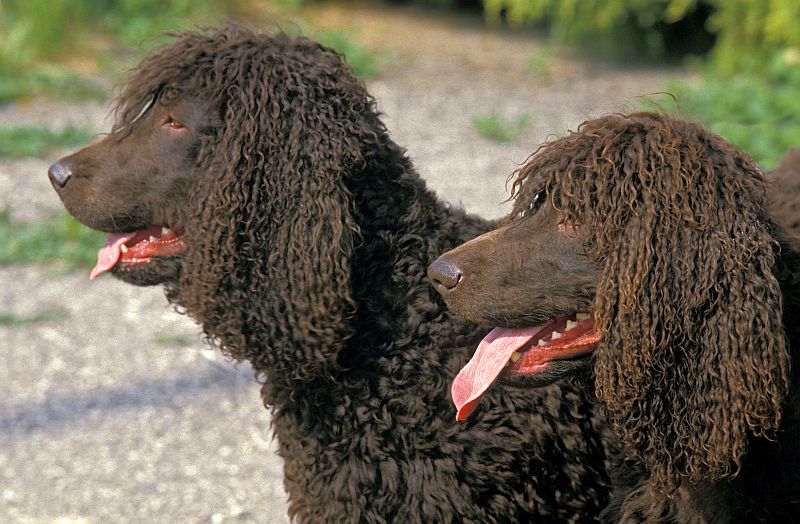
Last and by no means least, we have the Irish water spaniel. Not surprisingly given their name, these doggos love to swim.
They’re one of the most well-established spaniel breeds, said to have originated in the 7th century.
These webbed-foot dogs have wonderful springy curls as a coat (which are great for people who suffer from dog allergies), so it’s important to introduce grooming early on in the dog’s life so they learn it is a positive experience!
Irish water spaniels are typically awesome family dogs, and they usually get along well with kids. However, they rarely like being left alone and it’ll occasionally trigger separation anxiety.
***
Now admit it — you’re going to go check out your dog’s paws, aren’t you? Or did you already do that mid-article?
Let us know in the comments if your dog has webbed paws. Are they great swimmers? Always finding some mud to dig around in? We’d love to hear your stories!
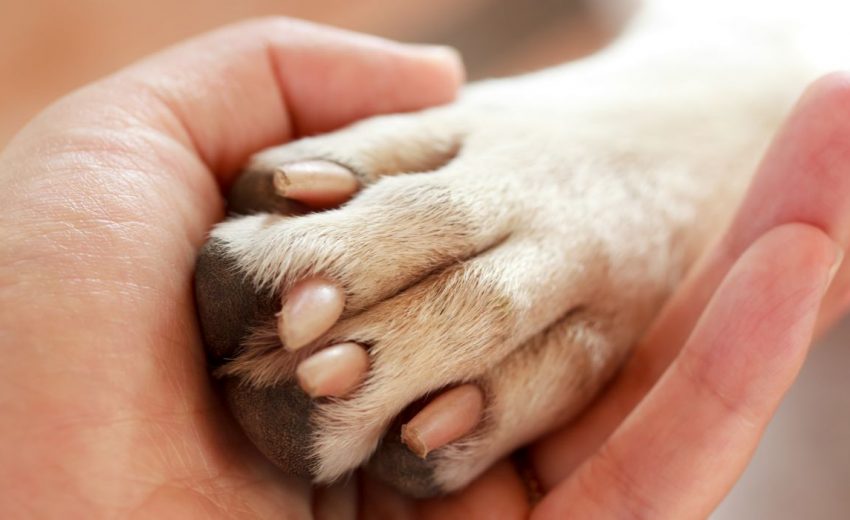




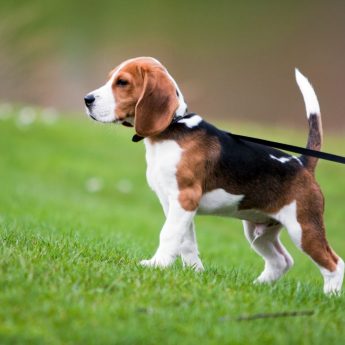

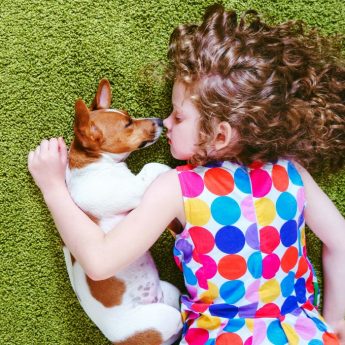
13 Comments
February 12, 2022
Does Maltese have web feet?
February 14, 2022
Not in the same way that Labs and some of the other dogs listed here do, Chris.
🙂
August 13, 2021
You stated that poodles originated in France that’s wrong they originated in Germany. Because the name poodle is actually a German word for puddle so you need to look up your facts before you put stuff like that in there okay.
August 16, 2021
You’re totally correct, Dianne — they are from Germany.
That’s my fault — I just didn’t catch the error when posting the article.
I’ve fixed it and appreciate you bringing it to our attention.
July 19, 2021
Our 2 adopted canines are mix breeds with webbed feet that love to dig. Neither are that interested in the pool for swimming. Faith and Marley were rescues that made their way to MA via GA.
June 29, 2021
Golden retrievers have webbed feet also!! They too are DRAWN to the water! I have a golden who’s 3 parts golden and 1 part poodle…so the webbed feet were inherited on both sides.
June 29, 2021
Totally correct, Shauntel!
We just went went the 13 discussed above, rather than every breed that has webbed feet.
Thanks for checking out the site!
June 16, 2021
You left out Catahoula Leopard Dogs, the official Lousiana State dog!
June 8, 2021
Flat-coated Retriever s also have webbed feet. In my humble opinion, they are also the best kept secret of all the dog breeds.
March 24, 2022
Black Mouth Curs, also have webbed feet and are extremely versatile. Them and Catahoula are my favorite. As for hunters no other dog will do.
November 20, 2022
You do not have Catahoulas or Black Mout Curs there
November 20, 2022
I should have read before posting. Thats what I said.
March 16, 2021
I was under the impression that salukis had webbed feet, but I didn’t see them mentioned as they were bred for deserts.
My saluki x greyhound had webbed feet